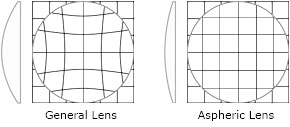Fragmentation: When plastic lens breaks, it breaks into larger fragments than their glass counterparts. Furthermore, the fragmented pieces are not as sharp as glass.
Fogging: CR39 lenses are less likely to fog-up than glass lenses because it responds more favorably to temperature changes.
Weight: Glass lenses are approximately 2X heavier than plastic lenses of similar size and shape. The lighter weight provides the wearer greater comfort.
Reflections: CR39 lenses have much lower internal reflection and surface glare than glass materials.
Tinting: CR39 lenses are great for tinting. Lenses can be tinted to virtually any color. Even lenses with variable thickness are able to be tinted evenly.
Fogging: CR39 lenses are less likely to fog-up than glass lenses because it responds more favorably to temperature changes.
Weight: Glass lenses are approximately 2X heavier than plastic lenses of similar size and shape. The lighter weight provides the wearer greater comfort.
Reflections: CR39 lenses have much lower internal reflection and surface glare than glass materials.
Tinting: CR39 lenses are great for tinting. Lenses can be tinted to virtually any color. Even lenses with variable thickness are able to be tinted evenly.
Aspherical lens design reduces lens thickness and weight. Furthermore, it eliminates spherical aberration and barrel distortion resulting from traditional lens design. The image will be sharper and clearer.


Lenses have a specific gravity of 1.31 g/cm3, which is almost half the weight of a crown glass lens of the same size.
All of lenses have excellent impact resistance to protect the wearer from injuries. The lenses have passed both the European Committee for Standardization (CEN) Strength Norm Test and the US Food and Drugs Administration (FDA) Balldrop Test.
FDA Ball Drop Test Parameters:
1. The impact test will consist of a 5/8 inch steel ball weighing approximately 0.56 ounces
2. The ball should be dropped from a height of 50 inches from the horizontal upper surface of the lens
3. The geometric center of the lens should be struck by the ball within a 5/8 inch diameter circle
4. There cannot be anything restricting the fall of the ball
5. A tube may be used to guide the ball to the lens; the ball may be dropped through a tube extending to within approximately 4 inches of the lens.

1. The impact test will consist of a 5/8 inch steel ball weighing approximately 0.56 ounces
2. The ball should be dropped from a height of 50 inches from the horizontal upper surface of the lens
3. The geometric center of the lens should be struck by the ball within a 5/8 inch diameter circle
4. There cannot be anything restricting the fall of the ball
5. A tube may be used to guide the ball to the lens; the ball may be dropped through a tube extending to within approximately 4 inches of the lens.
